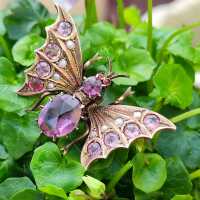In the Scottish Highlands around 1870, a brooch was created that captures the essence of this wild and untamed land. This piece of jewellery, influenced by the Victorian era in which the romanticism of Scottish culture was revived by the pen of Walter Scott, radiates the mysticism and splendour of Scotland.
The front of the brooch is studded with agate slices in colours ranging from deep red to soft orange and dark green. Each stone, carefully selected and cut, is unique. The natural stripe patterns of the agates tell stories of times gone by, when wind and water shaped the Scottish Highlands. These "Scotch Pebbles", as they are affectionately known, are not only treasured for their beauty, but also for their origin. The geometric Highland motifs reflect the traditional designs that were often found in the clothing and weapons of the Scottish clans. These patterns are not just decorative; they serve as a code that reflects the affiliation, history and struggles of the clans over the centuries.
The brooch can be worn both as a pendant and as a traditional brooch, making it a versatile companion. Its duality reflects the multi-layered identity of Scotland itself - rough and wild on the one hand, delicate and full of poetry on the other.
In the period in which this brooch was created, Scottish jewellery was coveted throughout Britain, driven by a fashion inspired by the nostalgic and romantic depictions of Scotland in literature. This brooch is therefore not only a testament to craftsmanship, but also a reflection of the social trends of the time. A truly magical legacy that stands the test of time.
For further information, see Charlotte Gere/Judy Rudoe: Jewellery in the Age of Queen Victoria, London: British Museum Press 2010, pp. 454-461.
Dimensions & details
- Silver tested
- Weight 16.24 g
- Diameter 5 cm
To describe the product, it may be necessary to use registered trademarks, brand names, or manufacturer names.
These are the property of their respective owners and are used solely for descriptive purposes.
This item is subject to differential taxation. Therefore, the VAT included in the purchase price is not shown separately on the invoice.
Decorative items are not included in the scope of delivery unless otherwise stated.



